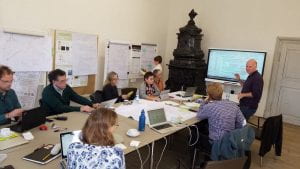On this page, Johannes jots down some thoughts on scientific publishing, some specific publications, and science in general.
December 1, 2020
Angela Possinger’s paper on Organo-organic and organo-mineral interfaces in soil at the nanometer scale just came out and provides an opportune moment to reflect on the collaborations that made this study possible. Without our colleagues from physics in the Department of Applied Physics, Professors Lena Kourkoutis and David Muller, we would surely not be able to do any of these experiments. By now means less important was the full buy-in of their graduate students Michael Zachman and Barnaby Levin, who were part of this journey from planning the measurements to writing the manuscript. Akio Enders, as always, provided the critical technical knowledge and the ideas to make it happen. To all of these go my heartfelt thanks. But I am also reminded how critical these collaborations are, how rare, and how tenuous. And how much more discoveries there would be if we had the ability to institutionalize such joint research. Despite the undeniable emphasis on and recognition of interdisciplinary science all around, structural and cultural barriers make these breakthrough scientific endeavors still an exceptions. They rely on unusual tenacity of individual graduate students to build bridges and on the willingness and interest of other graduate students to help their peers. All this comes at a cost of time and material that is not supported by the institutions or external donors. But how much fun it is to see it come together when it does. Let’s have more fun…
August 2, 2020
Our “Perspectives” article with the challenging title “Persistence of soil organic carbon caused by functional complexity” just came out, and I want to take the opportunity to clarify that the thoughts laid out in it were the result of a group engagement. We all made the effort to take time and travel to a remote place in south-eastern Bavaria, and spend a few days in 2018 at a monastery to talk, think, argue, eat, and wander around. The 500-year-old monastery Raitenhaslach is maintained by the TU Munich as a retreat and conference center, and it served its purpose well. I had been at another workshop nearly a decade earlier, organized by Michael Schmidt, and it was just as memorable. A stimulating environment and a pleasant atmosphere is in my view key to the quality of the scientific discourse.
Several things came together to make the workshop a success. Without a genuine interest by all participants in the topic, the discussions would not have led to any exciting conclusions. But there are very mundane issues that have to work out: the staff at the Institute for Advanced Study (IAS) at the TU Munich held our back free, not only during the preparations and travel reimbursements, but also while we were at Raitenhaslach. This allowed us to not worry about the inevitably numerous complications and logistical details that international travel brings.
A brief report from TUM-IAS here.
Scientific collaborations – reflections on writing the perspective
Collaborations are challenging. They are of course the only way to advance science, but they are rarely easy. And that is as it may need to be, as seeing someone else’s viewpoint and wrestling with contrasting opinions cannot be easy. That also means, we must not shy away from different opinions but leverage them for generating new insight. Unfortunately, our modes of operation are not fully adapted and often not even potentially equipped to foster collaborations and the needed discourse. Taking the time to spend several days together was key to learning from each other and being creative.
Contradictions and diverse opinions should not be fully resolved. This seems to be a paradox. Should science not arrive at facts that all accept? Yes, but there are many intermediate steps that need to bear the imprint of the discourse. Immutable truths are not found in one swoop and are rarely simple and without nuance. This is as valid for identifying the shape of the Earth as it is for figuring out the nature of soil organic matter.
Our publication, as many or even any scientific publication, bears many contradictions and remnants of unresolved discourse. We actually stated at the outset that arriving at a least common denominator was not an option: the novel insights to be gained by restating accepted facts are nil. We wanted to bring new thoughts into the center and let them clash with our long-held believes. That also means that the final text is testament to divergent opinions rather than complete agreement with all statements.
What if those nuggets of insights bearing the contradictions of the scientific discourse are the seeds of new thought that have the most lasting effect of a publication?


